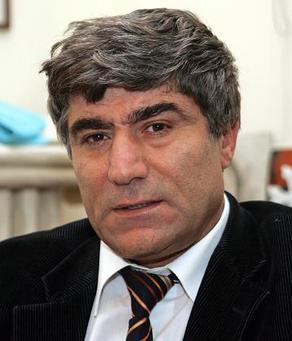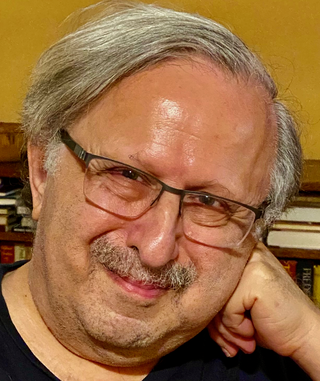
Üsküdar is a municipality and district of Istanbul Province, Turkey. Its area is 35 km2, and its population is 524,452 (2022). It is a large and densely populated district on the Anatolian (Asian) shore of the Bosphorus. It is bordered to the north by Beykoz, to the east by Ümraniye, to the southeast by Ataşehir and to the south by Kadıköy; with Karaköy, Kabataş, Beşiktaş, and the historic Sarayburnu quarter of Fatih facing it on the opposite shore to the west. Üsküdar has been a conservative cultural center of the Anatolian side of Istanbul since Ottoman times with its landmark as well as numerous tiny mosques and dergahs.

Ferit Orhan Pamuk is a Turkish novelist, screenwriter, academic, and recipient of the 2006 Nobel Prize in Literature. One of Turkey's most prominent novelists, he has sold over 13 million books in 63 languages, making him the country's best-selling writer.

Yervant Odian was an Ottoman Armenian satirist, journalist and playwright. He is regarded as one of the most influential Armenian satirists, along with his contemporary Hagop Baronian. He is best known for his work Comrade Panchooni, a satire mocking the Armenian revolutionary parties of the time.

The mass media in Turkey includes a wide variety of domestic and foreign periodicals expressing disparate views, and domestic newspapers are extremely competitive. However, media ownership is concentrated in the hands of a few large private media groups which are typically part of wider conglomerates controlled by wealthy individuals, which limits the views that are presented. In addition, the companies are willing to use their influence to support their owners' wider business interests, including by trying to maintain friendly relations with the government. The media exert a strong influence on public opinion. Censorship in Turkey is also an issue, and in the 2000s Turkey has seen many journalists arrested and writers prosecuted. On Reporters Without Borders' Press Freedom Index it has fallen from being ranked around 100 in 2005 to around 150 in 2013.

Srpouhi Dussap was an Armenian feminist writer and the first female Armenian novelist. She was the sister of famed Ottoman Armenian politician Hovhannes Vahanian.

The deportation of Armenian intellectuals is conventionally held to mark the beginning of the Armenian genocide. Leaders of the Armenian community in the Ottoman capital of Constantinople, and later other locations, were arrested and moved to two holding centers near Angora. The order to do so was given by Minister of the Interior Talaat Pasha on 24 April 1915. On that night, the first wave of 235 to 270 Armenian intellectuals of Constantinople were arrested. With the adoption of the Tehcir Law on 29 May 1915, these detainees were later relocated within the Ottoman Empire; most of them were ultimately killed. More than 80, such as Vrtanes Papazian, Aram Andonian, and Komitas, survived.
Armenians in Turkey, one of the indigenous peoples of Turkey, have an estimated population of 40,000 to 50,000 today, down from a population of over 2 million Armenians between the years 1914 and 1921. Today, the overwhelming majority of Turkish Armenians are concentrated in Istanbul. They support their own newspapers, churches and schools, and the majority belong to the Armenian Apostolic faith and a minority of Armenians in Turkey belong to the Armenian Catholic Church or to the Armenian Evangelical Church. They are not considered part of the Armenian Diaspora, since they have been living in their historical homeland for more than four thousand years.

Hrant Dink was a Turkish-Armenian intellectual, editor-in-chief of Agos, journalist, and columnist. As editor-in-chief of the bilingual Turkish-Armenian newspaper Agos, Dink was a prominent member of the Armenian minority in Turkey best known for advocating Turkish–Armenian reconciliation and human and minority rights in Turkey. He was often critical of both Turkey's denial of the Armenian genocide and of the Armenian diaspora's campaign for its international recognition. Dink was prosecuted three times for denigrating Turkishness, while receiving numerous death threats from Turkish nationalists.

Şahan Arzruni is a New York–based Armenian classical pianist, ethnomusicologist, lecturer, composer, writer and producer.

Ardashes Harutiunian was an Ottoman Armenian poet, a self-educated translator from French and literary critic.

Rober Haddeciyan, also known as Rober Haddeler, is an Armenian writer, playwright, and since 1967 editor-in-chief of Marmara, an Armenian-language daily newspaper.

Zabel Yesayan was an Armenian writer and a prominent figure in the Armenian academic and political community during the late nineteenth and early twentieth centuries. Zabel Yesayan's books, articles, and speeches cover a range of topics such as the Adana massacre, Armenian genocide, and commentary on the status of Armenian women. Yesayan also worked as a translator in France as well as a professor during her later years as an academic. Her novels and articles contributed to understanding the persecution of Turkish Armenians, the after effect of World War I, and women's roles and rights in the Ottoman and Armenian communities.

Armenians in Istanbul are a major part of the Turkish Armenian community and historically one of the largest ethnic minorities of Istanbul, Turkey. The city is often referred to as Bolis (Պոլիս) by Armenians, which is derived from the ending of the historical name of the city Constantinople.

Zaven Biberyan was an Armenian writer, editor, and author from Turkey.
Getronagan is an Armenian minority high school in the Karaköy district of Istanbul, Turkey, The school is attached to the Saint Gregory the Illuminator Church.

Arshaguhi Teotig was an Armenian social worker, educator, publicist, writer, and translator.
Yervant Gobelyan was a Turkish poet and writer of Armenian ethnicity.
Lara Aharonian is a Lebanese Canadian Armenian rights activist. She is the Director of the Women's Resource Centre in Yerevan. She has been recognised as a "Woman of Courage" by the United Nations.
Iskouhi Minas also known as Iskuhi Minas, and Iskouhi Minasyan, was a French novelist and poet.














